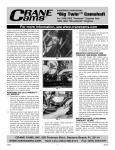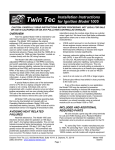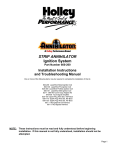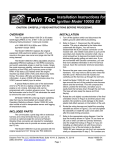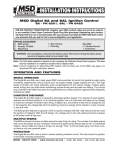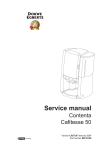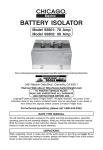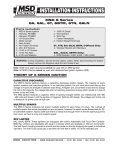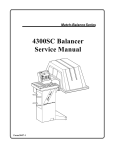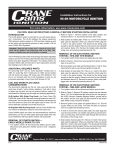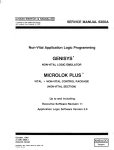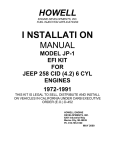Download Instructions
Transcript
INSTALLATION INSTRUCTIONS for HI-6S PERFORMANCE IGNITION SYSTEM Part Number 6000-6300 CAUTION: READ INSTRUCTIONS CAREFULLY BEFORE STARTING INSTALLATION OVERVIEW - READ FIRST!! The optional HI-6TR Timing Retard Control (P/N 6000-6470) adds 0-20 degrees adjustable retard. A boost sensor can be added to give 0-4 degrees per psi boost proportional retard. Refer to page 18. Before proceeding with the HI-6S installation, read the introductory material below and on pages 2-4. Then use the Applications Index to find the appropriate section for your vehicle. INTELLIGENT MULTI-SPARK INTRODUCTION Multi-spark is generated by repeatedly turning the coil current on and off during the spark sequence. At low RPM, during cranking, the HI-6S generates upwards of 12 sparks. This assures quick starting even under the most adverse conditions. At idle and cruise, the number of sparks fired is adjusted to maintain a total spark duration of about 20 degrees (crankshaft), assuring smooth idle, improved throttle response, and eliminating the lean surge characteristic of some late model emission controlled vehicles. During acceleration at higher RPM levels, the HI-6S generates a single powerful spark with about twice the spark gap energy of O.E. systems (with use of recommended LX-91 or PS-91 coil). The Crane HI-6S part number 6000-6300 is a multi-spark inductive ignition specially optimized for street driven performance vehicles with an engine redline below 8,000 RPM. A RISC microcontroller manages all functions of the HI-6S including the two stage rev limiter and timing retard capability. The lower stage of the rev limiter can also be used as an anti-theft function by using a switch hidden under the dash to select a very low rev limit that keeps the engine from running above idle (details on page 12). The HI-6S is intended for use with vehicles equipped with original equipment (O.E.) electronic ignition and computer engine control. Crane LX91 or PS-91 coils are recommended for optimum performance, however the HI-6S is compatible with most O.E. coils. Some late model vehicles with fuel injection or OBD II On Board Diagnostic system may require Crane P/N 6000-8950 Universal Trigger adapter when installing the HI-6S. The HI-6S is not compatible with distributorless ignitions. The HI-6S is 50 states legal (California Air Resources Board E.O. D-225-59) for vehicles without OBD II. SEQUENCE REV LIMITER The HI-6S has a built in two stage rev limiter that can be set via rotary trimpots from 1,000 to 5,000 RPM for the stage rev limit and 4,000 to 8,000 RPM for the maximum rev limit. The HI-6S utilizes a sequential firing program to equalize cylinder firing at the rev limit. When engine RPM exceeds the rev limit, firing stops. The HI-6S counts the number of cylinder firings that are skipped. Once RPM drops below the rev limit, firing is resumed when the count reaches an odd number. If the engine is held against the rev limit, RPM will stay within a narrow band. All cylinders will be fired equally in rotation. Fuel loading and plug fouling will be greatly reduced. For most V6 and V8 engines, cylinders will fire in alternate banks. This helps to minimize harmonics and vibrations that can stress engine and drivetrain parts. APPLICATIONS INDEX All except Honda and OBD II . . . . . . . . . . . . . . .Page 4 (most 1981 and up vehicles with O.E. electronic ignition and engine control computer, and 197286 Mopar with 4 or 5 pin module) DIAGNOSTICS Honda and Acura Integra . . . . . . . . . . . . . . . . . Page 5 (with O.E. electronic ignition and external or internal coil) A status LED is provided to assist in basic troubleshooting. When the ignition switch is turned on, the HI-6S completes an internal diagnostic check and lights up the status LED. When the engine is cranked, the status LED will blink to indicate that a valid trigger signal is being received. All vehicles with OBD II Diagnostics . . . . . . . .Page 12 (hookup with Universal Trigger adapter. Also use for problem vehicles where fuel injection or tach will not function properly after HI-6S installation) SPARK PLUGS AND WIRES Do not use solid copper core spark plug wires, or non-resistor spark plugs with the HI-6S, as this can generate electrical 530 Fentress Boulevard, Daytona Beach, FL 32114 Tech Line: (386) 258-6174 Fax: (386) 258-6167 Check our web site for updates: www.cranecams.com 3/99 1 9000-6300A noise that may interfere with the HI-6S or other on-board computer and radio equipment. Ground hookup. Connect the heavy black HI-6S wire directly to chassis ground. Use the supplied 3/8” ring terminal. The use of O.E. high resistance carbon or suppression spark plug wires is not recommended, as this will cause a significant loss of spark energy. For optimum results, use low resistance spark plug wires, such as Crane FireWire spiral core. Wire resistance should be 300-900 ohms per foot. +12 volt hookup. Connect the red HI-6S wire to switched +12 volt power. In most applications, switched +12 volt power is available at the Coil+ terminal. Refer to your vehicle wiring diagram. If you are unsure which terminal is Coil+, use the following procedure. Label and then disconnect O.E. wires from the coil. Turn the ignition switch on. Use a 12 volt test light or voltmeter. The wire from the ignition switch to Coil+ will be hot. Resistor spark plugs are required for all applications unless recommended otherwise by vehicle manufacturer. Use manufacturer’s recommended plug gap. Ballast resistance. Some vehicles (such as Ford with Duraspark ignition and early Chrysler with 4 or 5 pin electronic ignition modules) use ballast resistance. This can be in the form of a ballast resistor or resistance wire between the ignition switch and Coil+ terminal. For proper operation of the HI-6S, ballast resistance must be bypassed. Locate the ballast resistor or resistance wire (refer to your vehicle service manual). Bypass it with heavy 14 or 16 AWG stranded wire. If this is not practical, you can add an ignition power relay using the hookup shown in Figure 13. COIL COMPATIBILITY WARNING: High voltage is present at the coil primary and secondary terminals. Do not touch the coil while the engine is running. Do not connect any test equipment to the coil. If you are unsure whether or not your vehicle has ballast resistance, measure the voltage at the Coil+ terminal while the engine is idling. If the Coil+ voltage is less than 11 volts, your vehicle probably has ballast resistance that must be bypassed. Most O.E. coils used on late model vehicles with electronic ignition are compatible with the HI-6S. Maximum recommended primary resistance is .6 ohms. Optimum results, and a significant increase in spark energy will be obtained by using the Crane LX91 or PS-91 coil. The HI-6S is specially tuned for use with Crane LX-91/PS91 coils. Coil. Remove all O.E. wires from Coil- terminal. These O.E. wires will be connected to the HI-6S in the next step. Connect the yellow HI-6S wire to the Coil- terminal. Trigger. Connect the white HI-6S wire to all O.E. wires that were removed from the Coil- terminal above. The white wire is the trigger input to the HI-6S. It requires a 12 volt signal, such as that from the output of an O.E. ignition module. This type of trigger signal is sometimes referred to as a “module” or ”points” trigger signal. Note: the HI-6S cannot be triggered directly from a Hall Effect or magnetic pickup. INSTALLATION A parts bag with hardware and electrical terminals is provided for your convenience. All connections must be made with stranded copper wire. Crimp terminals are recommended over soldering, which can make wires brittle near the solder joint. Make sure all terminals are clean and free of corrosion. Scrape off paint, dirt, and grease when making connections to ground. You will require common hand tools including a proper wire stripping and crimping tool. Do not attempt to use pliers to crimp terminals. Tach. In most cases the O.E. connections to the tach (and possibly fuel injection system) are made to the Coil- terminal. Sometimes these connections are within the wire harness and are not brought out to Coil- as separate wires. If you connected all O.E. wires that went to Coil- to the white HI-6S trigger wire as instructed above, your tach and fuel injection should continue to function. If not, you may have to use the Crane Universal Trigger accessory as described on page 12 and the hookup shown in Figure 11. MOUNTING THE HI-6S UNIT The HI-6S is fully encapsulated and capable of withstanding high temperatures and water splash.. However salt spray and corrosive cleaning agents may in time attack the anodized finish. For this reason, Crane recommends mounting the unit in the passenger compartment if possible. Cylinder Select. The blue HI-6S wire is used to program the rev limiter and retard feature for the correct number of cylinders. Refer to Figure 2. For 8 cylinder engines, tape up the blue wire. For 4 cylinder engines, connect the blue wire to the red switched +12 volt wire with a 3M splice. For 6 cylinder engines, connect the blue wire to ground with a 1/4” ring terminal. Make sure that the HI-6S mounting location is away from exhaust system heat, protected from salt water splash, and has good airflow for cooling. When you have picked a mounting location, make sure that the wire harness will reach and that the rev limiter trimpots are accessible. Use the supplied sheet metal screws for mounting. At least two screws should be used to secure the unit. Stage Limit. The orange HI-6S wire can be connected to a normally open switch to select the stage rev limit as shown in Figure 3. +12 volts applied to the orange wire selects the stage rev limit. If the orange wire is left open or grounded, the maximum rev limit is active. Tape up this wire if it is not used. In some applications, the stage input is connected to a switch that also controls a line lock or transmission brake solenoid valve. When the switch opens and current flow to the solenoid is interrupted, electrical transients BASIC HOOKUP This section explains the basic hookup of the HI-6S, as shown in Figures 1-3. You can use this hookup for applications not specifically referenced in the Applications Index. 3/99 2 9000-6300A Figure 1. Basic Hookup START BALLAST RESISTOR RUN IGNITION SWITCH 3M WIRE SPLICE +12V – ADD JUMPER ACROSS BALLAST RESISTOR + 12 VOLT BATTERY + RED SWITCHED +12V GROUND – COIL YELLOW COIL - M F WHITE TRIGGER HI-6S UNIT HEAVY BLACK CHASSIS GROUND M F NOTES: TYPICAL 1/4" MALE-FEMALE QUICK DISCONNECTS 1. Cylinder select, stage limit, and retard input connections not shown for clarity. 2. Some early models including Ford and Chrysler use ballast resistor or resistance wire. Add jumper to bypass ballast resistance. RPMX100 O.E. WIRE TO COIL - 3. Any condenser connected to O.E. Coil- wire must be disconnected and removed. 4. Crane LX91 coil recommended for maximum performance. TACHOMETER O. E. ELECTRONIC IGNITION MODULE CUT WIRE AND REMOVE CONDENSER IF NECESSARY CONDENSER 3/99 3 9000-6300A Figure 2. Cylinder Select Hookup 3M WIRE SPLICE +12V FROM IGNITION SWITCH RED SWITCHED +12V 4 CYLINDER CONNECT TO +12V HI-6S UNIT BLUE CYLINDER SELECT 8 CYLINDER TAPE UP 6 CYLINDER CONNECT TO GROUND and distributor with vacuum advance). These GM HEI systems with vacuum advance require triggering directly from the magnetic pickup. Use the Crane HI-6 CD system for these GM HEI applications. (up to 500 volts) occur. These transients can lead to glitches in onboard electronics. The solution is to install the supplied surge absorber. It will limit the maximum voltage to about 40 volts. The surge absorber appears as a small 1/2 inch diameter disk with two wire leads. Solder one lead to the stage switch and the other lead to a terminal that connects to ground as shown in Figure 3. The HI-6S will be triggered from the output of the O.E. electronic ignition module. Before starting, identify all O.E. wires to the ignition coil. Use the hookups shown in Figures 5-9 for common Ford and GM applications. Refer to Figure 1 for all other applications. Hookup is as follows: Retard Input. The brown HI-6S wire can be connected to a 1 Kohm (1000 ohms) potentiometer and normally open switch as shown in Figure 3 or to the optional HI-6TR Timing Retard Control. If you plan to add this optional module, please read the material starting on page 18 for more details. 1. Connect black HI-6S ground wire to a good chassis ground. 2. Identify Coil+ and Coil- terminals. If your vehicle has ballast resistance, bypass or install the power relay circuit. CAUTION: If the retard feature is not used, you must connect the brown wire to switched +12 volt as shown, or the timing will always be retarded 20 degrees. 3. Refer to the previous section for details. Connect the red HI-6S switched +12 volt wire to the Coil+ terminal. 4. Remove O.E. wire(s) from Coil- terminal. Tie all these wires together and connect them to the white HI-6S trigger wire. If the basic connection with a potentiometer and switch is used, up to 20 degrees of retard can be commanded when the switch is closed. The potentiometer should be a 1 Kohm minimum 2 watt unit with a “linear” (not audio) taper, such as a Clarostat RV4LAYSA102A available from Digi-Key Electronics (1-800-3444539). 5. Connect the yellow HI-6S Coil- wire to the Coil- terminal. There should not be any other wires connected to Coil-. 6. Tach and fuel injection. In some cases, the trigger wires for tach and fuel injection will be connected to the O.E. module output somewhere within the vehicle wire harness and will not be brought out to Coil- as separate wires. Usually these systems will continue to function properly. If the tach or fuel injection doesn’t work, you may have to use the Universal Trigger adapter described on page 12. HOOKUP INSTRUCTIONS FOR SPECIFIC APPLICATIONS LATE MODEL VEHICLES WITH O.E. ELECTRONIC IGNITION 7. Some O.E. systems may have a condenser at the coil or near the ignition module. Disconnect and remove the condenser. Use this hookup for most late model vehicles with O.E. electronic ignition. Note that the HI-6S cannot be used with GM vehicles with 4 or 5 pin HEI modules (typically 1974-1980 model years 3/99 4 9000-6300A Figure 3. Stage Limit and Retard Hookup SWITCHED +12V 0 20 1K POT RETARD ADJUST CAUTION: IF RETARD INPUT NOT USED, CONNECT BROWN WIRE TO SWITCHED +12V NORMALLY OPEN RETARD SWITCH BROWN RETARD INPUT TARD RE HI-6TR OPTIONAL HI-6TR RETARD CONTROLLER ORANGE STAGE LIMIT INPUT (TAPE UP IF NOT USED) HI-6S UNIT SWITCHED +12V NORMALLY OPEN STAGE LIMIT SWITCH GROUND GROUND LINE LOCK OR TRANSMISSION BRAKE SOLENOID VALVE INSTALL SUPPLIED SURGE ABSORBER IF SOLENOID VALVE IS USED Detailed instructions are given in the following sections. 8. Connect the blue HI-6S cylinder select wire as required for your engine. Connect the orange HI-6S stage rev limit and brown HI-6S retard input wires as required. HONDA EXTERNAL COIL HOOKUP 1. Refer to Figure 9. Connect black HI-6S ground wire to a good chassis ground. VEHICLES WITH HALL EFFECT SYSTEMS 2. Identify the two plugs on the Honda/Acura O.E. coil. Connect the HI-6S as shown. Use terminals and wire supplied in the parts bag. Note that some O.E. coils have only a single plug. Identify wires and connect similar to Figure 10. Most vehicles use blue color code for module output and tach connection to Coil- terminal and black-yellow color code for switched +12 volt power connection to Coil+ terminal. Connect all blue wires from O.E. harness to white HI-6S trigger wire. Connect yellow HI-6S Coil- wire to Coil- terminal. Connect red HI-6S switched +12 volt wire to Coil+ terminal and all O.E. black-yellow wires. Many late model vehicles, especially European vehicles, have O.E. Hall Effect ignition systems. Use the output of the O.E. electronic ignition to trigger the white HI-6S wire as shown in Figure 1. The Hall Effect pickup cannot directly trigger the HI-6S. 1972-86 MOPAR VEHICLES WITH 4 OR 5 PIN MODULES Use the output of the Mopar 4 or 5 pin module to trigger the white HI-6S wire as shown in Figure 1. All these vehicles have a ceramic ballast resistor mounted on the firewall. Four pin modules use a two terminal ballast resistor. You can bypass this resistor by soldering all the wires going to it together. Five pin modules use a four terminal ballast resistor. The ballast resistor also supplies power to the five pin module. Bypassing the resistor may damage the module. You must use the power relay circuit shown in Figure 13 if your vehicle has a five pin module. 3. Tach and fuel injection. Usually these systems will continue to function properly if left connected as is. If the tach or fuel injection doesn’t work, please call Crane Tech Support. 4. Connect the blue HI-6S cylinder select wire to the red +12 volt wire as shown in Figure 2 (for 4 cylinder engine). Connect the orange HI-6S stage rev limit and brown HI-6S retard input wires as required. HONDA AND ACURA INTEGRA Late model Honda and Acura Integra have either a distributor with internal coil or an external coil. The O.E. internal coil is not suitable for use with the HI-6S and must be replaced with a Crane PS91. Internal coil distributors can easily be converted to external coil by changing the distributor cap. 3/99 5 9000-6300A Figure 4. GM Internal HEI Distributor Hookup IMPORTANT! FOLLOW SEQUENCE FOR WIRES NOTES: 1. Use this hookup only for distributors without vacuum advance. HI-6S not compatible with GM 4 or 5 pin ignition modules used in vacuum advance distributors. 1/4" FEMALE QUICK DISCONNECTS 2. Cylinder select, stage limit and retard input connections not shown for clarity. GM HEAVY RED OR PINK SWITCHED +12V YELLOW COIL - HI-6S UNIT RED SWITCHED +12V HEAVY BLACK CHASSIS GROUND 12" RED JUMPER WIRE 12" BLACK JUMPER WIRE WHITE TRIGGER GM TACH WIRE (REMOVED FROM HEI CAP) USE 1/4" MALE TERMINAL SHORT LENGTH OF WHITE WIRE USE 1/4" MALE TERMINALS WARNING: GM COIL MUST BE GROUNDED WITH BLACK JUMPER WIRE AS SHOWN. TO GM MODULE 3/99 BROWN BLACK PINK 6 9000-6300A Figure 5. GM Early Model External HEI Distributor Hookup GM COIL CONNECTOR GM O.E. WIRE HRNESS 1/4" MALE TERMINALS JUMPER WIRES ACROSS AS SHOWN WHITE TRIGGER RED SWITCHED +12V 12" RED JUMPER WIRE HI-6S UNIT YELLOW COIL HEAVY BLACK CHASSIS GROUND F 1/4" FEMALE QUICK DISCONNECTS F NOTES: GM EARLY HEI COIL 1. Use this hookup only for distributors without vacuum advance. HI-6S not compatible with GM 4 or 5 pin ignition modules used in vacuum advance distributors. 2. Cylinder select, stage limit and retard input connections not shown for clarity. 3/99 7 9000-6300A Figure 6. GM Late Model External HEI Distributor Hookup M F GM O.E. HARNESS TO TACH AND IGNITION SWITCH TACH WHITE CUT AND TAPE UP SWITCHED +12V PINK 12" WHITE JUMPER WIRE 3M WIRE SPLICE PINK WHITE PINK GREY PLUG WHITE RED SWITCHED +12V BLACK PLUG LATE MODEL HEI COIL WITH DUAL PLUGS F M M F WHITE MODULE OUTPUT TO GM IGNITION MODULE YELLOW COIL- HI-6S UNIT WHITE TRIGGER HEAVY BLACK CHASSIS GROUND NOTES: 1. Cylinder select, stage limit and retard input connections not shown for clarity. 3/99 CAUTION: SOME 1990 AND LATER GM LT-1 ENGINES HAVE CONNECTIONS TO GREY AND BLACK PLUGS SWAPPED. VERIFY CORRECT HOOKUP BY TRACING O.E. WIRES OR REFERRING TO THE SERVICE MANUAL FOR YOUR VEHICLE. 8 9000-6300A Figure 7. Ford SSI and DuraSpark Hookup – USE HEAVY GAUGE (16 AWG MINIMUM WIRE) + 12 VOLT BATTERY IGNITION POWER RELAY RADIO SHACK 275-226 FORD SWITCHED +12V GROUND FORD COIL – 87 86 GROUND M TYPICAL 1/4" MALE-FEMALE QUICK DISCONNECTS M F USE 1/4" FEMALE QUICK DISCONNECTS FOR RELAY CONNECTIONS F 85 30 F RED SWITCHED +12V FORD COIL “HORSESHOE” CONNECTOR M M F YELLOW COIL- HI-6S UNIT WHITE TRIGGER HEAVY BLACK CHASSIS GROUND CAUTION: WHEN USING THE RELAY CIRCUIT SHOWN, YOU MUST ALSO ADD A DIODE BETWEEN THE VOLTAGE REGULATOR AND CHARGING INDICATOR LAMP AS SHOWN IN FIGURE 14 TO PREVENT RUN ON. NOTES: 1. Most Ford SSI and Duraspark systems have a ballast resistance wire between Coil+ and the ignition switch. Use the relay to supply +12V power direct from the battery as shown. 2. Most standard 12V automotive relays use the pin numbers shown above and can be substituted for the Radio Shack part. 3. Cylinder select, stage limit and retard input connections not shown for clarity. 4. Ford coil is not recommended, replace with Crane LX91 for optimum results. 3/99 9 9000-6300A Figure 8. Ford TFI Hookup FORD COIL CONNECTOR DARK GREEN & YELLOW RED & LIGHT GREEN 1/4" MALE TERMINALS RED SWITCHED +12V WHITE TRIGGER HI-6S UNIT 12" RED JUMPER WIRE YELLOW COILHEAVY BLACK CHASSIS GROUND F 1/4" FEMALE QUICK DISCONNECTS F NOTES: 1. Cylinder select, stage limit and retard input connections not shown for clarity. FORD E CORE COIL 3/99 10 9000-6300A Figure 9. Honda External Coil Hookup 3M WIRE SPLICE TO O.E. IGNITION MODULE SWITCHED +12V BLK-YEL TOP VIEW OF HONDA COIL MODULE OUTPUT BLUE SMALL PLUG F F M M TYPICAL 1/4" MALE-FEMALE QUICK DISCONNNECTS YELLOW COILWHITE TRIGGER BLUE LARGE PLUG TAPE UP SWITCHED +12V BLK-YEL RED SWITCHED +12V M F LENGTH OF WHITE WIRE FROM PARTS BAG TACH BLUE TO O.E. IGNITION SWITCH AND TACH 2.2 K OHM 1/2 WATT RESISTOR - SEE NOTES HI-6S UNIT NOTES: HEAVY BLACK CHASSIS GROUND 1. Cylinder select, stage limit and retard input connections not shown for clarity. 2. Some Honda coils have a single connector. In this case, identify individual wires and connect same as shown above. 3. If tach or fuel injection is erratic, add 2.2 Kohm resistor in blue tach wire as shown. Solder leads or use two butt splices. Wrap with electrical tape. 3/99 11 9000-6300A HONDA INTERNAL COIL CONVERSION thus prevents any interaction with the OBD II system. The fuel injection and tach also continue to see the normal signal waveforms that these systems require for proper operation. 1. Refer to Figure 10. Remove the distributor cap and dust shield. The dust shield is generally not required and can be discarded. Note the O.E. wiring hookup within the distributor. Remove the O.E. coil (held in place with two screws). Install a 2 position terminal block as shown. You can use Radio-Shack P/N 274656 or a similar part available from electronic supply stores. Tie wrap the terminal block to one of the coil mounting holes or fabricate a support bracket from aluminum channel material. Connect the O.E. coil wires to the terminal block as shown. When the Universal Trigger adapter senses a high voltage pulse from the O.E. coil, it generates a trigger signal for the HI-6S. The Universal Trigger adapter also controls +12 volt power to the HI-6S. When the engine is started, power is applied to the HI-6S after sensing about 2-3 high voltage pulses. When the ignition switch is turned off and the O.E. ignition stops firing, the Universal Trigger adapter cuts power to the HI-6S after a delay of 2 seconds. The Universal Trigger adapter is supplied with a parts bag that includes several types of coil terminals and boots, including the special terminals used on some Chevy LT-1 engines. Select the terminal and boot that best fits your coil. 2. You will require an external coil distributor cap. You can use Honda P/N 30102-PT3-A12 for most 92-97 Honda and Acura Integra models. Check the Crane web site for availability of adapters for other models. Drill a 3/8” wire exit hole in the cap at the approximate location shown in the figure. Install the rubber grommet supplied in the parts bag. You will need to install a second coil for use with the HI-6S. We recommend the Crane LX-91 or PS-91 for optimum results. If you cannot use the original cable, you may also need to fabricate a length of high voltage cable from the new coil to the distributor cap. We recommend the use of low resistance (300-900 ohms per foot) spiral core cable). The Universal Trigger parts bag includes low resistance spiral core cable and assorted coil and distributor terminals and boots. 3. Connect black HI-6S ground wire to chassis ground. 4. Route the white HI-6S trigger wire and red HI-6S switched +12 volt wires along with an additional red +12 volt wire for the Coil+ connection through the hole in the new distributor cap and connect to the terminal block as shown using small ring terminals. Note that Figure 11 shows a direct connection from the Battery+ terminal to Coil+. Power is always applied to the Coil+ terminal. When the HI-6S is powered down by the Universal Trigger adapter, only a very small leakage current will flow through the coil. For additional protection, you can add a 10 amp fuse in this circuit. 5. PS-91 coil connections. Connect the red +12 volt wire to the Coil+ terminal. Connect the yellow HI-6S Coilwire to the Coil-terminal. Use the plug supplied with the PS-91. You will have to fabricate a high voltage cable for use between the coil and new distributor cap. STAGE REV LIMIT FEATURE - USE AS THEFT DETERRENT Refer to Figure 3. A normally open switch is used to select the stage rev limit. When +12 volts is applied to the orange HI-6S wire, the stage rev limit is selected. If you do not require two rev limit stages, tape up the orange wire. 6. Tach and fuel injection. Usually these systems will continue to function properly if left connected as is. If the tach or fuel injection doesn’t work, please call Crane Tech Support. The stage rev limit can also be used as a theft deterrent feature. You can install a hidden switch under the dash and set a very low rev limit, such as 1,000 RPM. The vehicle will start but not run above idle. A thief will think that the vehicle is defective. 7. Connect the blue HI-6S cylinder select wire to the red +12 volt wire as shown in Figure 2 (for 4 cylinder engine). Connect the orange HI-6S stage rev limit and brown HI-6S retard input wires as required. REV LIMITER OBD II DIAGNOSTIC SYSTEM EQUIPPED VEHICLES Select safe rev limits that are less than the red line for your engine. Set the trimpots on the HI-6S to the selected stage and maximum rev limits. The stage limit range is 1,000 to 5,000 RPM. The maximum rev limit range is 5,000 to 9,000 RPM. Use the label underneath the unit as a guide to setting the trimpots. Use the small screwdriver supplied in the parts bag to adjust the trimpots. The trimpots only turn about 270 degrees as shown on the label. To avoid damage, do not apply excessive force or attempt to turn the trimpots past the stops If your vehicle is equipped with an OBD II On Board Diagnostic system, you must use the Crane P/N 6000-8950 Universal Trigger adapter and the hookup shown in Figure 11. This eliminates the need to tap into the O.E. wiring harness on the coil primary side. Connection of aftermarket equipment to the O.E. wiring harness may cause the OBD II malfunction indicator light to come on. The HI-6S continually reads rev limit settings while the engine is running below 3,000 RPM. When adjusting the rev limits while the engine is running, let the engine return to idle momentarily after making an adjustment. If your vehicle has a fuel injection system and will not run or the tach does not function properly after installing the HI-6S, you must also use the Universal Trigger adapter. The Universal Trigger adapter connects to the high voltage terminal on the O.E. coil. It simulates a normal spark plug load and 3/99 12 9000-6300A O.E. HOOKUP Figure 10. Honda Internal Coil Hookup TO O.E. HARNESS O.E. COIL IGNITION MODULE + - INPUT FROM ECU HONDA 30102-PTS A12 CAP RED SWITCHED +12V MODULE OUTPUT +12V TACH SIGNAL TO O.E. HARNESS TRIGGER 2 POSITION TERMINAL BLOCK DRILL 3/8" HOLE AND INSTALL RUBBER GROMMET FOR WIRE EXIT +12V RED SWITCHED +12V HI-6S UNIT WHITE TRIGGER YELLOW COIL- HEAVY BLACK CHASSIS GROUND NOTES: 1. Cylinder select, stage limit, and retard input connections not shown for clarity. + - RED (+12V TO COIL+) USE PLUG SUPPLIED WITH LX-91 LX91 COIL 2. Remove internal coil, use LX91 Coil and Honda Cap 30102-PTS-A12 for external coil. Drill hole thru cap for HI-6S wire exit. 3. Use 16 AWG wire for +12V connection to LX91 coil. 3/99 13 9000-6300A Figure 11. Universal Trigger Hookup +12V POWER USE HEAVY GAUGE (16 AWG MINIMUM) WIRE NEW HIGH VOLTAGE COIL WIRE TO DISTRIBUTOR (LOW RESISTANCE SPIRAL CORE WIRE RECOMMENDED) + – 12 VOLT BATTERY - + GROUND USE PLUG SUPPLIED WITH LX-91 LX91 COIL YELLOW COIL- HI-6S UNIT DISTRIBUTOR HEAVY BLACK CHASSIS GROUND RED SWITCHED +12V RED +12V POWER WHITE TRIGGER P/N 6000-8950 UNIVERSAL TRIGGER ADAPTER BLACK F M 1/4" MALE-FEMALE QUICK DISCONNECTS F M WHITE TRIGGER RED/WHITE SWITCHED +12V HIGH VOLTAGE CABLE (COIL LOAD) CHASSIS GROUND O.E. COIL NOTES: CAUTION: DO NOT REMOVE ANY WIRES CONNECTED TO O.E. COIL OTHER THAN THE HIGH VOLTAGE WIRE THAT ORIGINALLY CONNECTED THE DISTRIBUTOR 1. HI-6S cylinder select, stage limit, and retard input connections not shown for clarity. 2. High voltage cable from universal trigger adapter to O.E. coil: Install appropriate terminal and boot from supplied parts bag. 3/99 14 9000-6300A AFTERMARKET ACCESSORIES CHECKING FOR SPARK Many aftermarket accessories are compatible with the HI-6S system. Figure 12 shows hookup of typical accessories. Note that the HI-6S cannot be used with MSD timing controls, rev limiters, or triggered directly from magnetic pickup distributors, or crank triggers. To crank the engine without starting or to check for spark, use a KD Tools test plug. Make up a length of spark plug wire to connect the test plug to the coil. MISFIRE OR INTERMITTENT OPERATION 1. A weak battery may cause misfire or intermittent operation, especially at high RPM. If in doubt, charge or replace the battery. MSD RPM sensing accessories such as the MSD 8950 RPM Activated Switch, 8940 Shift Alert, and 8952 Shift Light are compatible. Connect the trigger input wire on the MSD accessory (typically white) to the white HI-6S trigger wire. Refer to the MSD instructions for further details on hookup and operation of these units. 2. Field experience has shown that misfire at high RPM is usually not an electrical problem within the HI-6S. Coil failure and arcing at coil or plug connections are common causes. FINAL CHECK 3. Route all trigger signal connections away from any coil connections and spark plug wires. Before starting the engine for the first time, double check all electrical connections. Start the engine and verify that timing is set to manufacturer’s specifications. 4. Replace spark plugs, plug wires, distributor cap, and rotor. Use only spiral core plug wires. Verify plug gap and heat range. Check for loose or corroded connections. TROUBLESHOOTING HI-6S OPERATION RUNNING ON Did the engine run properly before installation of the HI-6S? If not, remove the HI-6S, reconnect the O.E. ignition or another known good unit and then find and correct the original problem. Did the HI-6S function correctly before the problem occurred? If the answer is yes, did you change anything that may have affected it? If you connected an external control or changed ignition coils, try going back to the last setup that worked OK to help isolate the problem. Running on is a condition where the engine continues to run after the ignition switch is turned off. First, verify that the condition is due to the ignition system. Dieseling can cause running on. The engine will run very rough when it is dieseling. This may be due to an overly rich mixture, excessive timing, or heavy carbon deposits. Dieseling can usually be cured by installing colder spark plugs. With ignition run on, the engine continues to run smoothly, as if the ignition had not been turned off. Run on problems can occur when using the ignition power relay circuit shown in Figure 7 or 13. Current leaks through the charging system indicator light and keeps the relay energized even when the ignition switch is turned off. To solve this problem, install the supplied diode on the voltage regulator. If the engine will not start, or runs rough or intermittently, follow the checklist steps given in the following sections. NO STATUS LED WHEN IGNITION IS ON If the status LED doesn’t light up after the ignition switch is turned on, check power and ground connections. Use a volt meter to verify +12 volts at the red HI-6S wire and the Coil+ terminal. Also verify +12 volts when the ignition switch is in the start position. During cranking, the HI-6S will continue to operate down to about +5 volts. GM or Ford with external voltage regulator: refer to Figure 14. For GM vehicles, install the diode on the #4 terminal. For Ford vehicles, install the diode on the terminal marked “I”. ENGINE WILL NOT START GM vehicles with Delcotron alternator and internal regulator: refer to Figure 16. Install the diode in the thin brown wire going to the indicator light. 1. If the status LED lights up when the ignition switch is turned on but the engine will not start, verify that the status LED blinks while the engine is cranking. Installation of the diode may not correct the run on problem on some vehicles. Refer to Figure 16. Use a 1973-76 Chrysler dual ballast resistor (available at most parts stores). Solder a jumper wire across both terminals on one end. Then connect the terminals on the other end to ground and to the ignition switch wire. The ballast resistor sends the leakage current to ground. 2. If the status LED doesn’t blink, the HI-6S is not receiving a trigger signal. Recheck trigger signal electrical connections and trigger source. 3. If the status LED blinks, but engine will not start, recheck coil primary connections or replace coil. The only wire going to Coil- should be the yellow HI-6S wire. Tach and fuel injection systems must be connected to the white HI-6S trigger wire. If the hookup is correct and the engine will not start upon installation of an HI-6S system, the fuel injection may not be receiving a proper trigger signal. You may need to use the Universal Trigger adapter on page 12. 3/99 RADIO NOISE All ignition systems generate some noise. A powerful multispark ignition system such as the HI-6S will tend to generate more noise than the O.E. ignition. To some extent this is unavoidable, but steps can be taken to reduce the noise level. Radio frequency (RF) noise is radiated from coil and spark plug wires. RF noise primarily affects AM and CB radios. Conducted noise from the coil primary is carried through +12 volt 15 9000-6300A Figure 12. Accessory Hookup SWITCH OUTPUTS NORMALLY CLOSED NORMALLY OPEN +12V YELLOW MSD RPM SWITCH RED RT IFT SH GREY ALE 40 . 89 NO RT PA WHITE BLACK GROUND AUTOMETER OR MSD SHIFT LIGHT +12V RED HI-6S UNIT GREEN BLACK GROUND 3M WIRE SPLICE AFTERMARKET TACH TRIGGER SOURCE (O.E. IGNITION MODULE) WHITE TRIGGER DASH LIGHTS +12V RED WHITE 7 GREEN NOTES: 6 5 4 RPM 3 1. HI-6S power, coil, and other signal wires not shown for clarity. 2. Multiple accessories may be connected to the HI-6S white trigger wire. 8 9 10 2 1 0 BLACK GROUND 3. Typical Autometer tach hookup shown, other aftermarket units similar, check instructions for wire colors. CAUTION: DO NOT CONNECT ANY AFTERMARKET ACCESSORIES TO COIL- TERMINAL 4. MSD RPM SWITCH: Refer to MSD instructions for hookup to normally closed and open outputs from RPM switch. 3/99 16 9000-6300A Figure 13. Ignition Power Relay Hookup O.E. WIRING START BALLAST RESISTOR RUN IGNITION SWITCH USE HEAVY GAUGE (16 AWG MINIMUM WIRE) SWITCHED +12V +12V – + 12 VOLT BATTERY IGNITION POWER RELAY RADIO SHACK 275-226 87 GROUND 86 GROUND 85 30 + RED +12V POWER YELL OW C OIL - HI-6S UNIT HEAVY BLACK CHASSIS GROUND COIL M WHITE TRIGGER – F M F NOTES: 1. Cylinder select, stage limit,and retard input connections not shown for clarity. TYPICAL 1/4" MALE-FEMALE QUICK DISCONNECTS 2. Most standard 12V automotive relays use the pin numbers shown above and can be substituted for the Radio-Shack part. 3. Any condenser connected to O.E. Coil- wire must be disconnected and removed. 4. Crane PS91 coil recommended for maximum performance. O.E. WIRE TO COIL - 3/99 17 RPMX100 O. E. ELECTRONIC IGNITION MODULE CUT WIRE AND REMOVE CONDENSER IF NECESSARY CAUTION: WHEN USING THE RELAY CIRCUIT SHOWN, YOU MUST ALSO ADD A DIODE IN THE CHARGING INDICATOR LAMP CIRCUIT AS SHOWN IN FIGURES 15 OR 16 TO PREVENT RUN ON. TACHOMETER CONDENSER 9000-6300A Figure 14. Diode Installation on External Regulator Use the following checklist to reduce RF noise: BROWN WIRE To No. 1 TERMINAL 1. Make sure a ground strap is installed between the engine and chassis. Make sure that the coil bracket is grounded. 2. Make sure that radio, tape and CB systems are grounded direct t to the chassis. 3. Mount the HI-6S unit as far away as possible from the antenna (including windshield antenna) and other electronic devices. Make sure the HI-6S is grounded direct to the chassis. Keep the ground wire short, preferably no more than 6”. 4. Replace spark plug wires with spiral core type wire. Replace rotor and cap. Apply a small amount of silicone dielectric grease to the rotor tip and to all high voltage terminals. Use only resistor spark plugs when running on the street. BUTT SPLICE No. 1 TERMINAL “BAT” TERMINAL 1N4007 DIODE BUTT SPLICE INDICATOR LAMP No. 2 TERMINAL NOTE: 1973-83 GM DELCOTRON USE BUTT SPLICES TO CONNECT DIODE, THEN WRAP WITH ELECTRICAL TAPE. Figure 15. Diode Installation on Delcotron Alternator VOLTAGE REGULATOR NOTE: USE BUTT SPLICES TO CONNECT DIODE, THEN WRAP WITH ELECTRICAL TAPE. INDICATOR LAMP EARLY GM VEHICLES ATTACH DIODE TO TERMINAL MARKED "4" 1N4007 DIODE BUTT SPLICE FORD VEHICLES ATTACH DIODE TO TERMINAL MARKED "I" BUTT SPLICE HI-6TR TIMING RETARD CONTROL ACCESSORY Figure 16. Run-On Fix Using Chrysler Ballast Resistor TO BATTERY+ 87 86 CHASSIS GROUND IGNITION SWITCH IGNITION POWER RELAY RADIO SHACK 275-226 85 30 CHRYSLER DUAL BALLAST RESISTOR JUMPER WIRE The Crane Cams HI-6TR is an accessory for HI-6S systems that provides driveradjustable retard. The HI-6TR can provide continuous timing retard (0° - 20°), retard using a switch (0° - 20°), or retard proportional to boost (up to 4° per psi) on supercharger or turbocharger installations (with an optional boost sensor, not included). INSTALLATION Complete the installation of the HI-6S ignition module prior to installing the HI-6TR. Figure 17 shows hookup of the HI-6TR to the HI-6S. The red wire from the HI-6TR is connected to a key switched, +12 volt supply. You may splice it into the red wire on the HI-6S. The yellow wire from the HI-6TRC is connected directly to ground for continuous retard control, through a boost/nitrous switch to ground for retard on demand, or taped off when using the optional boost sensor. When using retard on demand, the switch must complete the circuit to ground to activate the retard (use a normally open switch or relay). +12V POWER TO COIL + AND HI-6S CHASSIS GROUND power connections. Conducted noise appears as a whine that follows engine RPM and may affect all systems including tape players and FM radio. 3/99 Conducted noise can be reduced by installing a power line noise filter (available at Radio Shack) near the affected radio. 18 9000-6300A FINAL CHECK Demand retard mode is also great for crank-trigger systems where a momentary start retard is required. A manual switch or a normally open relay energized by the starter solenoid can be used to ground the yellow wire during cranking to provide up to 20° of starting retard. Once the switch is released, timing returns to normal. Before starting the engine for the first time, double check all electrical connections. Set the HI-6TR knob to 0° (fully counterclockwise), then start the engine and check the ignition timing. The timing may change a few degrees after installation. Reset timing to manufacturer’s specs. Upon starting the engine, the LED on the HI-6TR module will be lit only if the yellow wire is grounded. Boost Proportional Retard Refer to Figure 17. An optional boost sensor (Crane P/N 9000-0110) is required for boost proportional retard. This sensor is a rugged unit that can measure pressures up to 15 psi above normal atmospheric pressure. The harness and mating connector are supplied. The yellow wire should be taped up. Use 1/4” I.D. fuel hose to plumb the sensor to your intake manifold. OPERATION The HI-6TR module allows you to adjust the amount of retard produced by the HI-6S. It also contains an LED that indicates when the retard function is activated. How you use the HI-6TR depends on whether you have connected it for continuous, demand, or boost-proportional retard. When the boost sensor is connected, the retard setting on the HI-6TR now refers to a retard slope from 0° to 4° per psi of boost. Simply divide the knob setting by 5 to determine the retard slope (see Figure 20 below). For example, if the knob is set to 5° the retard slope is 1° per psi and at 5 psi of boost the retard is 5°. As boost rises further, the retard increases at this same slope up to a maximum of 20°. If the boost level exceeds 15 psi, the retard levels off as shown in Figure 17 below (sensor damage may occur above 18 psi). Continuous Retard Refer to Figure 17. Connect the yellow wire from the HI-6TR directly to chassis ground for continuous retard. Since the retard feature is active all the time, the LED on the HI-6TR will be illuminated whenever the key is on. Turning the knob fully counterclockwise (0°) produces no retard. Turning the knob clockwise increases the retard up to 20°. The HI-6TR is approximately linear throughout its range, so half scale is about 10° of retard. For precise retard calibration, you must use a high-quality timing light. The status LED on the HI-6TR illuminates when retard is being applied. Under most conditions, this occurs between 0.5 and 1.0 psi of boost. As boost rises, retard rises with a slope determined by the knob setting. Note that the retard slope stops rising when the boost reaches 15 psi or the retard reaches 20°. The HI6TR is approximately linear throughout its range, but for precise retard calibration use a timing light to obtain retard value. The uses for this type of timing control include adjusting timing to prevent knock because of inferior fuel quality or insufficient octane, altitude adjustments, etc. As you drive, you can apply just the amount of retard required to prevent spark knock and optimize fuel economy. In racing applications the retard control can be used to tune the vehicle to specific track and atmospheric conditions. The HI-6TR also may be used on vehicles with mechanical advance distributor or computer engine controls to change the total ignition timing. TROUBLESHOOTING Did the engine run properly before installation of the HI-6TR? If not, remove the both the HI-6TR and HI-6S units, reinstall the OEM ignition or another known good unit and then find and correct the original problem. Make sure the HI-6S system functions properly before installing or troubleshooting the HI-6TR accessory. Did the HI-6TR function correctly before the problem occurred? If the answer is yes, did you change anything that may have affected it? If you connected an external control or changed ignition coils, try going back to the last setup that worked to help isolate the problem. Refer to the HI-6S installation instructions for more details, including the use of the HI-6S built-in diagnostic LED located on the ignition module. Demand Retard Refer to Figure 17. Connect the yellow wire from the HI-6TR to a normally open switch or relay that will complete a path to chassis ground when retard is desired. Example: A pressure switch that closes at a certain boost level. The LED on the HI-6TR will light up when the yellow wire is grounded. When the LED is lit, the retard feature is active and the spark is retarded by the amount set on the HI-6TR knob from 0° - 20°. The HI-6TR is approximately linear throughout its range, so half scale is abut 10° of retard. For precise retard calibration, you must use a high-quality timing light. The diagram below shows an example with the knob set for 10° of retard. If you are not getting the amount of retard you expect, check the LED on the HI-6TR module; it lights up when retard is being applied. If it does not light up in continuous or demand retard modes, check the yellow wire from the HI-6TR. It must contact a good chassis ground when retard is needed. Also re-check the brown wire connection from the HI-6TR to the HI-6S. This type of timing control is great for nitrous oxide and supercharged applications, or any vehicle that requires adjustable retard. For nitrous applications, Figure 17 shows how a normallyopen relay is used to ground the yellow wire when nitrous and fuel solenoids are activated. The pin numbers are for a standard automotive relay such as Radio Shack P/N 275-226. Figure 17 also shows a pressure activated switch designed to retard timing when the boost pressure reaches a pre-set value. NAPA Balkamp offers two adjustable pressure switches: P/N 701-1591 (3-7 psig range) and P/N 701-1603 (1.1-3 psig range). 3/99 In boost retard mode the amount of retard should be proportional to the pressure measured by the optional MAP sensor. The amount of retard may vary in a given application if local atmospheric (barometric) pressure changes significantly. This occurs most often with a change in altitude of 1000 feet or more. 19 9000-6300A Figure 17. HI-6TR Timing Retard Control Accessory Hookup NOTES: 1. The HI-6TR control module must have +12V power during engine start and run. The hookup shown avoids problems. If the HI-6TR red wire is connected to a separate +12V power source, verify that +12V power is present during cranking, otherwise timing will be retarded 20 degrees and the engine may be hard to start. 2. HI-6S ground, coil, and remaining signal connections not shown for clarity. Refer to appropriate HI-6S hookup figures for details. OPTIONAL MAP SENSOR PN 9000-0110 HI-6S UNIT RED (SWITCHED +12V) RED ( SWITCHED +12V) RETARD COMMAND BROWN BROWN TARD RE BLACK (GROUND) HI-6TR TIMING RETARD CONTROL MODULE HI-6TR YELLOW WIRE FROM HI-6TR TIMING RETARD CONTROL NORMALLY OPEN RELAY OR OR 87 86 85 30 TAPE UP WHEN USING BOOST RETARD FEATURE GROUND CHASSIS GROUND OR NITROUS SOLENOID PRESSURE SWITCH FUEL SOLENOID TO NITROUS TRIGGER CIRCUIT 0° KNOB AT 10° 20° MIN TIMING RETARD 20° MAX 10° KNOB AT 10° 0° MIN X TIMING RETARD 10° Yellow wire grounded via switch or relay MAX 20° Optional MAP Sensor installed. Yellow wire taped up DEMAND RETARD MA Yellow wire permanently grounded BOOST PROPORTIONAL RETARD TIMING RETARD CONTINUOUS RETARD T 5° BA KNO 5° 0° 0 5 15 10 BOOST (PSI) MIN 20 25 SWITCH OR RELAY ACTIVATED 3/99 20 9000-6300A





















